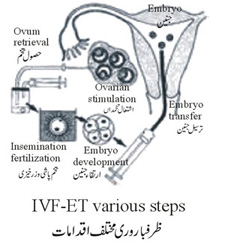 |
Page 1 |
|
In vitro Fertilization (IVF) and Embryo Transfer (ET) Literally means "fertilization outside the body" compared to in vivo fertilization which is "fertilization within the body”. In IVF fertilization occurs in the laboratory in an incubator filled with carbon dioxide. The provision varies from country to country. In vitro fertilization (IVF ) has obtained a central role in fertility management. Annual IVF cycles worldwide have approached above one million resulting in 1 in 100 to 1in 150 babies born today being IVF baby. Pure recombinant hormones have given us the real insight of the processes involved in reproduction.
Overview IVF commonly known as the test tube baby has allowed many infertile couples to conceive and have children. It is a technique where Sperm from the male are combined with the female's eggs in a round glass Petri dish where fertilization occurs. IVF bypasses the fallopian tubes and accordingly is the treatment of first choice for the women with absent or damaged non functional fallopian tubes. The basic principles of IVF are Removal of eggs from the ovary, their fertilization in the laboratory and Subsequent placement of the resulting embryos in the uterus. |
| IVF was first successfully performed in England in 1978. After years of successful use and refinement IVF is now recognized as a safe, effective, and a "first line" fertility treatment for many couples.
|
 |
IVF is offered to nearly all the couples where other treatments have NOT helped but is the only choice in women with blocked, non functioning Oviducts (commonly known as the tubes) and Men with severe problems of their Sperms. Intracytoplasmic sperm injections (ICSI) are a specialized technique of IVF for such men that revolutionized the treatment of male infertility. |
| After pretreatment evaluations, the couple attends the IVF center seven days before the onset of the periods (21st day of the ongoing cycle) to start the down regulation and then on 4th day after the onset of the menstruation of the desired menstrual cycle to begin the treatment. The complete treatment takes up to 25 days counting from the start of menstruation. |
Women usually grow a single egg in a month. In order to increase the chances of an IVF pregnancy the patient needs FSH injections that can induce several follicles to develop. A follicle is similar to a small droplet of water that contains the egg and is usually visualized on the screen of an ultrasound as a black circle. Hormones are administered for 12-15 days. Some resistant cases take longer to respond. The process is closely monitored using TVS. The dosage is adjusted during the cycle depending upon follicle growth. When FD is > 17 mm hCG injection is given. There can be 3 to 5 visits during ovarian stimulation before the Ovum Pick Up (OPU). All treatments are day care based. Admission is not needed.
|









